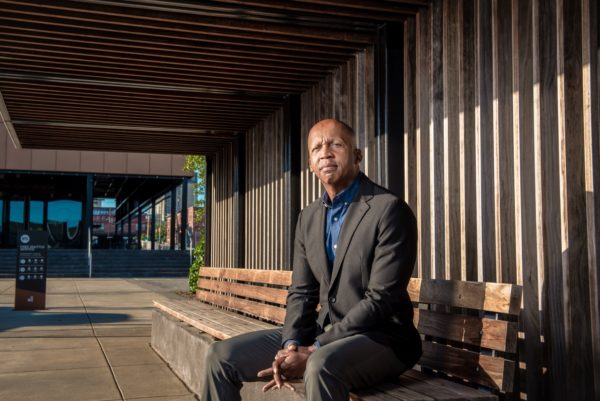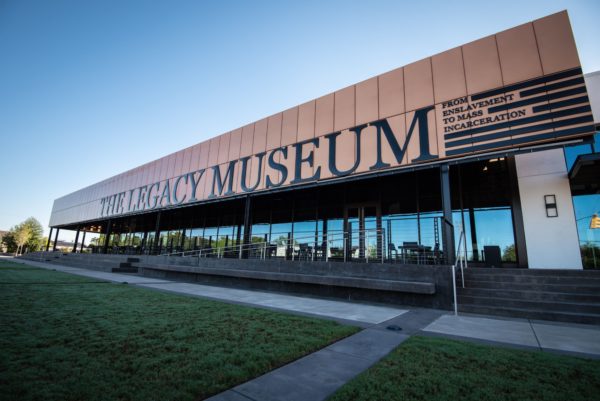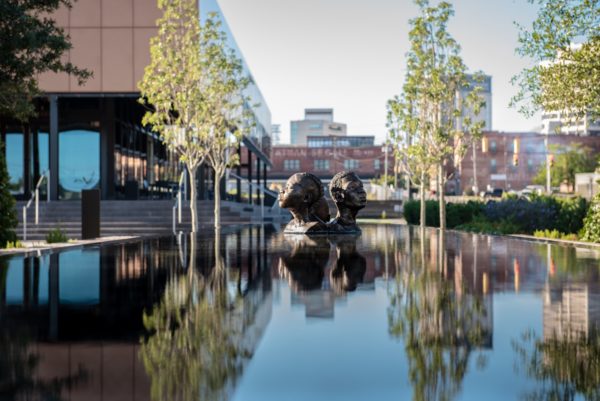By Jordyn Holman
Museums help cement historical narratives. The new Legacy Museum offers up a lesser-told narrative about the U.S. and slavery—one that implicates the entire country and its economy.
The Legacy Museum, in Montgomery, Alabama, is the latest manifestation of civil rights lawyer Bryan Stevenson’s decades-long work of getting America to confront the hard truths of its past. Three decades ago, Stevenson founded the Equal Justice Initiative, a non-profit that’s working to end mass incarceration. Over the years, he’s argued and won multiple cases in front of the U.S. Supreme Court.

In 2018, EJI and Stevenson opened the National Memorial for Peace and Justice in Montgomery, a sobering memorial to the more than 4,400 African Americans lynched in the U.S. He also opened up the original Legacy Museum, which focused on race-based oppression, linking the enslavement of Black people to their mass incarceration today.
At 40,000 square-feet, the new facility, a few blocks away from the former space, is four times larger and has ambitions much wider in scope. It’s meant to depict the violent realities of slavery and racism and how that has shaped every corner of American society.
“The vision for this space was really to have a much broader and expansive view of who we are in this country,” says Stevenson. “There is still such fundamental ignorance about the history of this country and the issues that were created by our history that continue to haunt us.” Before the pandemic, more than 450,000 people visited the memorial and original museum each year. Stevenson expects more than one million people annually coming to the expansion.

The museum’s depiction of who we are is raw, violent, painful, and, at times, hopeful.
Visitors get a chronological tour through 250 years of slavery, beginning with the Transatlantic Slave Trade—among the largest acts of forced migration ever. Sounds of crashing waves play as animated videos show the capture of 12 million people from Africa, who would never see their homeland again. Holograms of men, women, and children that activate when approached recount the anguish and pain of bondage. We can’t fully understand the horrors of slavery until we get close to them.
The building sits on land formerly occupied by a cotton warehouse, blocks from a prominent slave auction site and a rail station where tens of thousands of Black people were trafficked. But, inside, a considerable amount of space is dedicated to showcasing how the spoils of slavery reached far beyond the American South. Placards detail how in New York City, enslaved Black people cleared land for what would become Broadway and built parts of Wall Street. Banks, based there, accepted slaves as collateral for loans. Further north, Boston-based rum suppliers relied on slave labor in the West Indies; Rhode Island controlled about half of the ports that took in transatlantic traffickers.

A full loop through the dimly lit one-floor space is physically taxing and emotionally overwhelming—the experience can take hours. The exhibits don’t massage the language of violence. The brutal experience of Black enslavement, which for generations has been flattened or dismissed, is humanized over and over again. The journey doesn’t come without hope. The last few rooms feature African American contributions in science, technology and art.
The Legacy Museum adds to an emerging body of work—the 1619 Project; Isabel Wilkerson’s Caste; Ava DuVernay’s 13th—that draws a straight line from slavery to America’s ascendance as an economic powerhouse. It’s part of a growing movement for reconciliation, a formal process of acknowledging wrongdoing against a group of people, that last year’s murder of George Floyd and subsequent worldwide racial justice protests accelerated in the U.S. In 2020, Representative Barbara Lee introduced a bill in the U.S. House of Representatives to form a commission on Truth, Racial Healing, and Transformation.
Stevenson says last year was the first time the Equal Justice Initiative received corporate donations, which helped finance the museum, and that multiple companies reached out seeking his council.
A narrow majority of Americans say that this increased attention to U.S. history of racism is good for society, a survey from this summer by the Pew Research Center found. But there’s also been a backlash from conservative groups and politicians. In recent months, dozens of state and local legislatures have banned teaching “critical race theory — an academic analysis of how racism shapes laws, policies, and institutions — in schools. While CRT is generally only taught in higher education, proposed bills aim to restrict any discussions of race and racism in K-12 education.
Stevenson isn’t surprised by the pushback. “We’ve practiced silence about this history,” he says. “Largely, we’ve pretended as if it didn’t happen and there are no consequences.”
His museum is meant to be a corrective to that, no matter how uncomfortable it makes people. That’s part of the reconciliation process, he says.
He believes that we must identify and name harm before trying to fix a wrong. “What most of us are doing in presenting this history is inviting this country to move forward, urging this country to see that we are better than the history that we have inherited and that we can create a better future,” he says. “I hope we have the courage and the will and the desire to get to a better place.”
More stories like this are available on bloomberg.com.




